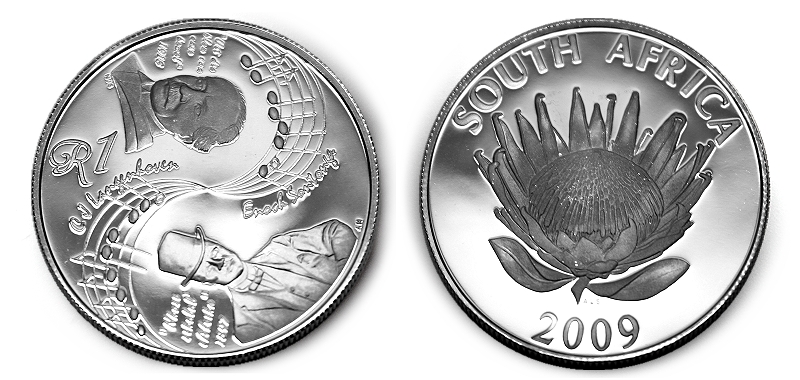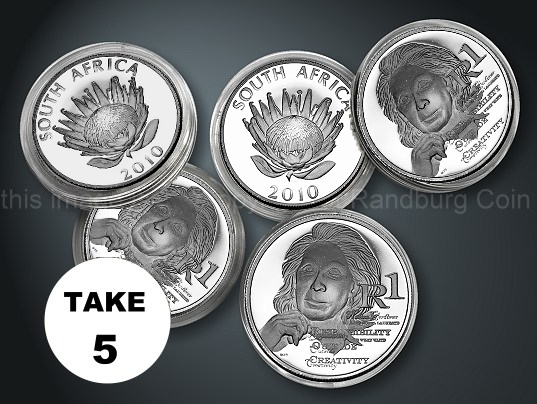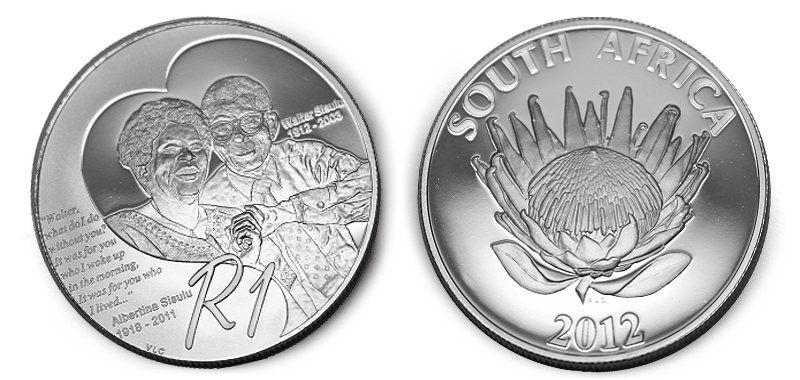2009 2010 2011 2012 Protea Silver Proof R1 Coins 4X coins
|
|
|
Dear Collectors TAKE ADVANTAGE OF OUR FAIR PRICES SILVER - AN ASSET CLASS - HISTORY IN YOUR HANDS ------------------------------------- STERLING SILVER PROTEA COMMEMORATIVE SERIES - NOW AVAILABLE ------------------------------------- ICONS OF SOUTH AFRICA REPUBLIC OF SOUTH AFRICA 2009 PROOF R1 PROTEA NATIONAL ANTHEM STERLING SILVER 15 GRAMS COMMEMORATIVE Enoch Sontonga, a Xhosa, was born in the city of Uitenhage in the Eastern Cape Colony. He trained as a teacher at the Lovedale Institution and subsequently worked as a teacher and choirmaster at the Methodist Mission school in Nancefield, near Johannesburg for eight years. The first verse and chorus of Nkosi Sikelel' iAfrika was composed in 1897 and it was originally intended to be a school anthem. Some sources say he wrote the tune the same year, but others note that the tune (Aberystwyth) was written by Joseph Parry and Sontonga wrote new words. It was first sung in public in 1899 at the ordination of Reverend Mboweni, who was the first Tsonga Methodist minister. Later the Xhosa poet Samuel Mqhayi wrote a further seven verses. Sontonga died in 1905. C J Langenhoven's most famous work is the original South African Anthem Die Stem, which he wrote in 1918. Parts of this anthem have been incorporated into the current national anthem, used since the abolition of apartheid in 1994. To celebrate the centenary of his birth, in 1973 the South African Post Office issued a series of stamps (in 4-cent, 5-cent and 15-cent denominations). Langenhoven's writing career spanned almost every genre, from poetry to ghost and alien stories. He also translated several works into Afrikaans, amongst these was the Rubaiyat of Omar Khayyam. He was instrumental in the movement for the acceptance of Afrikaans as a language, and for it to be taught as the first language in schools instead of Dutch. This culminated in the language officially being used in parliament in 1925, and by 1927 it was recognised as an official language of South Africa , together with English NOW OFFERING NUMISMATIC ITEMS AT A COMPETITIVE MARKET RATE AVAILABLE - CALL TO CONFIRM
images are generic - images strictly copyright of Randburg Coin A BEAUTIFUL COIN COMMEMORATING SOUTH AFRICA'S AUTHORS OF THE NATIONAL ANTHEM NOW AT A REMARKABLE OFFER A UNIQUE NUMISMATIC STERLING SILVER ITEM A FAVOURABLE PRICE AS SEEN BELOW WE ARE NOW SELLING THIS PROOF R 380 ea REPUBLIC OF SOUTH AFRICA 2010 PROOF R1 PROTEA NADINE GORDIMER STERLING SILVER 15 GRAMS COMMEMORATIVE 1991 Nobel Prize in Literature Her works began achieving literary recognition early in her career, with her first international recognition in 1961, followed by numerous literary awards throughout the ensuing decades. Literary recognition for her accomplishments culminated with the NOBEL PRIZE FOR LITERATURE IN 1991, which noted that Gordimer "through her magnificent epic writing has—in the words of Alfred Nobel—been of very great benefit to humanity". Home-bound and often isolated, she began writing at an early age, and published her first stories in 1937 at the age of fifteen. Her first published work was a short story for children, "The Quest for Seen Gold," which appeared in the Children's Sunday Express in 1937; "Come Again Tomorrow," another children's story, appeared in Forum around the same time. At the age of 16, she had her first adult fiction published. Her writing has long dealt with moral and racial issues. Gordimer studied for a year at the University of the Witwatersrand, where she mixed for the first time with fellow professionals across the different faculties. She also became involved in the Sophiatown renaissance. She did not complete her degree, but moved to Johannesburg in 1948, where she has lived ever since. While taking classes in Johannesburg, Gordimer continued to write, publishing mostly in local South African magazines. She collected many of these early stories in Face to Face, published in 1949.
images are generic - images strictly copyright of Randburg Coin A BEAUTIFUL COIN COMMEMORATING SOUTH AFRICA'S NOBEL LAUREATE WINNER, NOW AT A REMARKABLE OFFER A UNIQUE NUMISMATIC STERLING SILVER ITEM A FAVOURABLE PRICE AS SEEN BELOW WE ARE NOW SELLING THIS PROOF R 280 ea ICONS OF SOUTH AFRICA REPUBLIC OF SOUTH AFRICA 2011 PROOF R1 PROTEA JOHN MAXWELL COETZEE STERLING SILVER 15 GRAMS COMMEMORATIVE 2003 Nobel Prize in Literature
On 2 October 2003, Horace Engdahl, head of the Swedish Academy, announced that Coetzee had been chosen as that year's recipient of the Nobel Prize in Literature, making him the fourth African writer to be so honoured and the second South African, after Nadine Gordimer. When awarding the prize, the Swedish Academy stated that Coetzee "in innumerable guises portrays the surprising involvement of the outsider". The press release for the award also cited his "well-crafted composition, pregnant dialogue and analytical brilliance", while focusing on the moral nature of his work. The prize ceremony was held in Stockholm on 10 December 2003.
images are generic - images strictly copyright of Randburg Coin A BEAUTIFUL COIN COMMEMORATING THE NOBEL LAUREATE WINNER FOR LITERATURE JM COETZEE A UNIQUE NUMISMATIC STERLING SILVER ITEM A FAVOURABLE PRICE AS SEEN BELOW WE ARE NOW SELLING THIS PROOF R 280 ea REPUBLIC OF SOUTH AFRICA 2012 PROOF R1 PROTEA WALTER AND ALBERTINA SISULU STERLING SILVER 15 GRAMS COMMEMORATIVE The 2012 Protea Coin Series is themed "The Greatest South African Love Story" featuring Walter and Albertina Sisulu. Born only miles apart in the Eastern Cape hinterland, Walter Sisulu (1912-2003) and Albertina Thethiwe (1918-2011) went on from these humble beginnings to become two of South Africa's most respected and beloved figures. Their life together was marked by frequent arrests and detentions as Walter Sisulu led campaigns to defy apartheid laws. Walter Sisulu had been jailed more than once when he went underground in 1963. Albertina and their eldest son were detained by police frustrated in their attempts to find Walter. Active in ANC Women's League affairs and in the 1980s, copresident of the United Democratic Front, Albertina was banned for nearly two decades and often jailed. They reunited only after liberation movements were unbanned in 1990, several months after Walter Sisulu was released from Robben Island. The R1 sterling silver Protea coin depicts the portraits of Walter and Albertina Sisulu and a quotation from Albertina Sisulu, which was read out at the funeral of Walter Sisulu. "Walter, what do I do without you? It was for you who I woke up in the morning, it was for you who l lived ... "
images are generic - images strictly copyright of Randburg Coin A BEAUTIFUL COIN CELEBRATING THE GREATEST SOUTH AFRICAN LOVE STORY NOW AT A REMARKABLE OFFER A UNIQUE NUMISMATIC STERLING SILVER ITEM A FAVOURABLE PRICE AS SEEN BELOW WE ARE NOW SELLING THIS PROOF R 280 ea OR
WE BELIEVE THESE SELLING PRICES TO BE FAIR A GREAT OPPORTUNITY TO OBTAIN TO RESERVE
|










